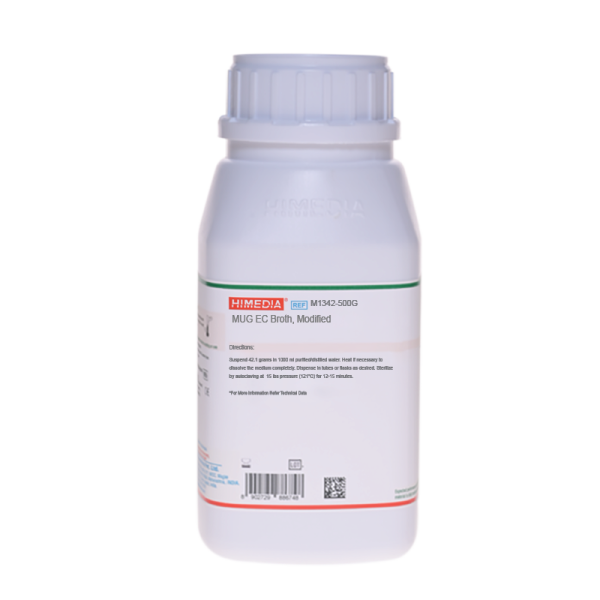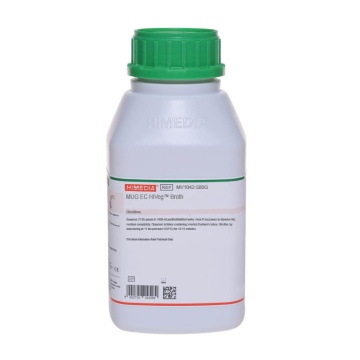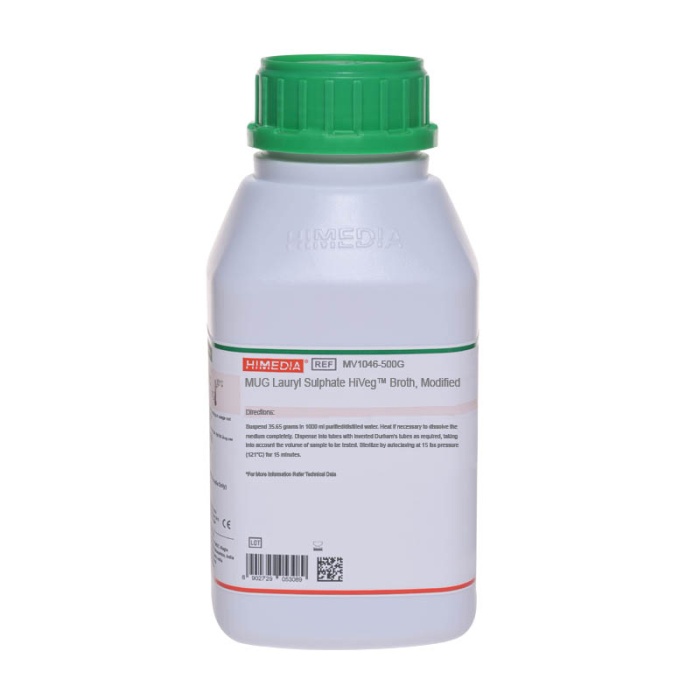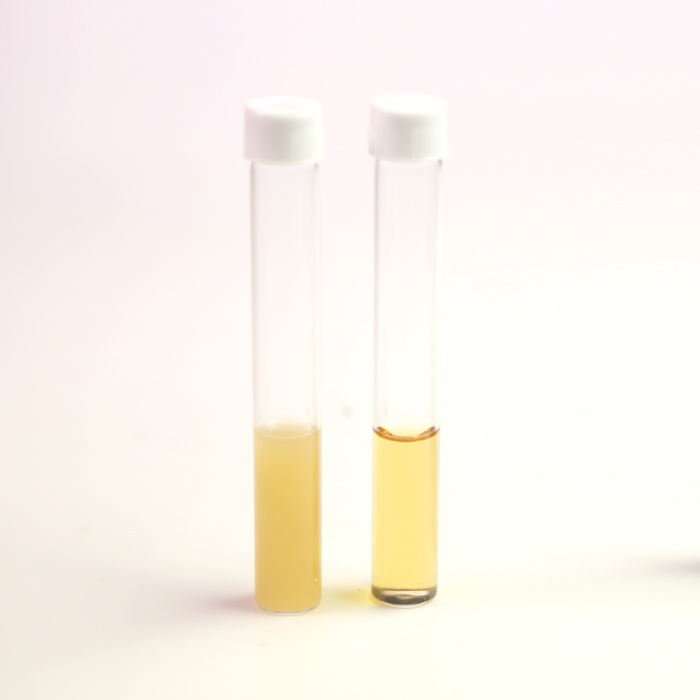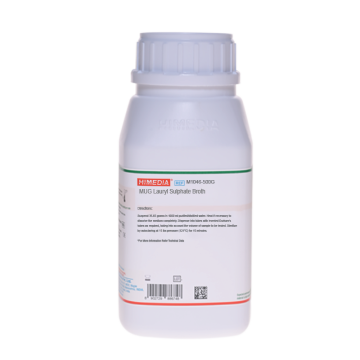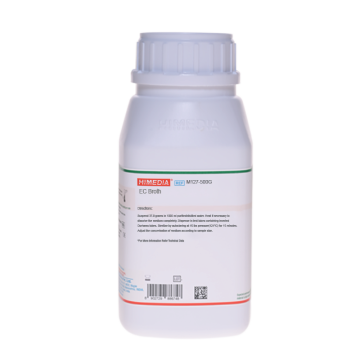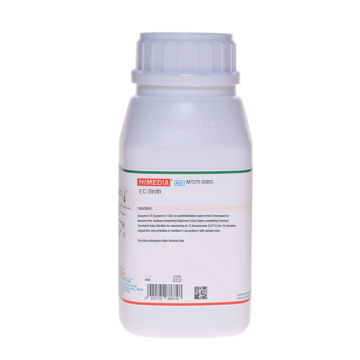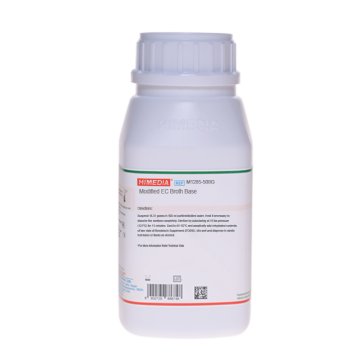 Your enquiry has been submitted
Your enquiry has been submitted
MUG EC Broth, Modified
Intended use
Recommended for the detection and enumeration of Escherichia coli in surface and waste water by miniaturized method (MPN). The composition and performance criteria of this medium are as per the specifications laid down in ISO 9308-3:1998
Composition**
| Ingredients | g/L |
|---|---|
| Tryptone | 40.000 |
| Salicin | 1.000 |
| Triton X-100 | 1.000 |
| MUG (4-methylumbelliferyl-b-D-glucuronide) | 0.100 |
| Final pH (at 25°C) | 6.9±0.2 |
**Formula adjusted, standardized to suit performance parameters
Directions
Suspend 42.1 grams in 1000 ml purified/distilled water. Heat if necessary to dissolve the medium completely. Dispense into tubes or flasks as desired. Sterilize by autoclaving at 15 lbs pressure (121°C) for 12-15 minutes.
Principle And Interpretation
EC Broth is recommended as per ISO committee for detection of Escherichia coli and coliform bacteria (1). It was also devised by Hajna and Perry (2) for the detection of Escherichia coli and coliforms. This was further modified by the addition of the fluorogenic compound MUG (3) for rapid detection of E. coli. MUG permits rapid detection of E. coli when medium is observed under UV light for fluorescence (3,4). MUG also detects anaerogenic strains which may not be detected in conventional procedure (3). MUG is hydrolyzed by an enzyme ß-glucuronidase possessed by Escherichia coli to yield a fluorescent end product 4-Methylumbelliferone.
Tryptone provides essential nutrients. Salicin act as energy sources and Triton X-100 acts as a surfactant. Following incubation, observe tubes for growth and fluorescence under long-wave (366nm) UV light. Positive reaction exhibits bluish fluorescence. Some strains of Salmonella and Shigella may also produce glucuronidase therefore these must be distinguished from E.coli on the basis of other parameters i.e. growth at 44°C and other biochemical tests.
Type of specimen
Water samples.
Specimen Collection and Handling
For water samples, follow appropriate techniques for sample collection, processing as per guidelines and local standards (1,5). After use, contaminated materials must be sterilized by autoclaving before discarding.
Warning and Precautions :
Read the label before opening the container. Wear protective gloves/protective clothing/eye protection/ face protection. Follow good microbiological lab practices while handling specimens and culture. Standard precautions as per established guidelines should be followed while handling specimens. Safety guidelines may be referred in individual safety data sheets.
Limitations :
- This medium is general purpose medium and may not support the growth of fastidious organisms.
- Individual organisms differ in their growth requirement and may show variable growth patterns on the medium.
Performance and Evaluation
Performance of the medium is expected when used as per the direction on the label within the expiry period when stored at recommended temperature.
Quality Control
Appearance Cream to yellow homogeneous free flowing powder
Colour and Clarity of prepared medium Light amber coloured clear solution
Reaction Reaction of 4.21% w/v aqueous solution at 25°C. pH : 6.9±0.2
pH 6.70-7.10
Cultural Response Productivity: Cultural response was observed after an incubation at 44 ± 0.5°C for 48 hours.
| Organism | Inoculum (CFU) | Growth | Fluorescence under 366 nm |
|---|---|---|---|
| Productivity | |||
| Escherichia coli ATCC 25922 (00013*) | 50-100 | luxuriant | positive, blue |
Key : *Corresponding WDCM numbers
Storage and Shelf Life
Store between 10-30°C in a tightly closed container and the prepared medium at 20-30°C. Use before expiry date on the label. On opening, product should be properly stored dry, after tightly capping the bottle in order to prevent lump formation due to the hygroscopic nature of the product. Improper storage of the product may lead to lump formation. Store in dry ventilated area protected from extremes of temperature and sources of ignition Seal the container tightly after use. Product performance is best if used within stated expiry period.
Disposal
User must ensure safe disposal by autoclaving and/or incineration of used or unusable preparations of this product. Follow established laboratory procedures in disposing of infectious materials and material that comes into contact with sample must be decontaminated and disposed of in accordance with current laboratory techniques (6,7).
Reference
- International Organization for Standardization. Water quality: Detection and enumeration of E.coli and coliform bacteria. in surface and waste water ISO 9308-3:1998.
- Hajna A. A. and Perry C. A., 1943, Am. J. Public Health 33 : 550.
- Feng P. C. S and Hartman P. A. S., 1982, Appl. Environ Microbiol., 43:132.
- Robinson J., 1984, Appl. Environ. Microbiol, 48: 285.
- Lipps WC, Braun-Howland EB, Baxter TE,eds. Standard methods for the Examination of Water and Wastewater, 24th ed. Washington DC:APHA Press; 2023.
- Isenberg, H.D. Clinical Microbiology Procedures Handbook. 2nd Edition.
- Jorgensen, J.H., Pfaller, M.A., Carroll, K.C., Funke, G., Landry, M.L., Richter, S.S and Warnock., D.W. (2015) Manual of Clinical Microbiology, 11th Edition. Vol. 1.
| Product Name | MUG EC Broth, Modified |
|---|---|
| SKU | M1342 |
| Product Type | Regular |
| Physical Form | Powder |
| Origin | Animal |
| Packaging type | HDPE |
| References | 1. Hajna A. A. and Perry C. A., 1943, Am. J. Public Health 33 : 550. |
| Customized Product Available | No |



